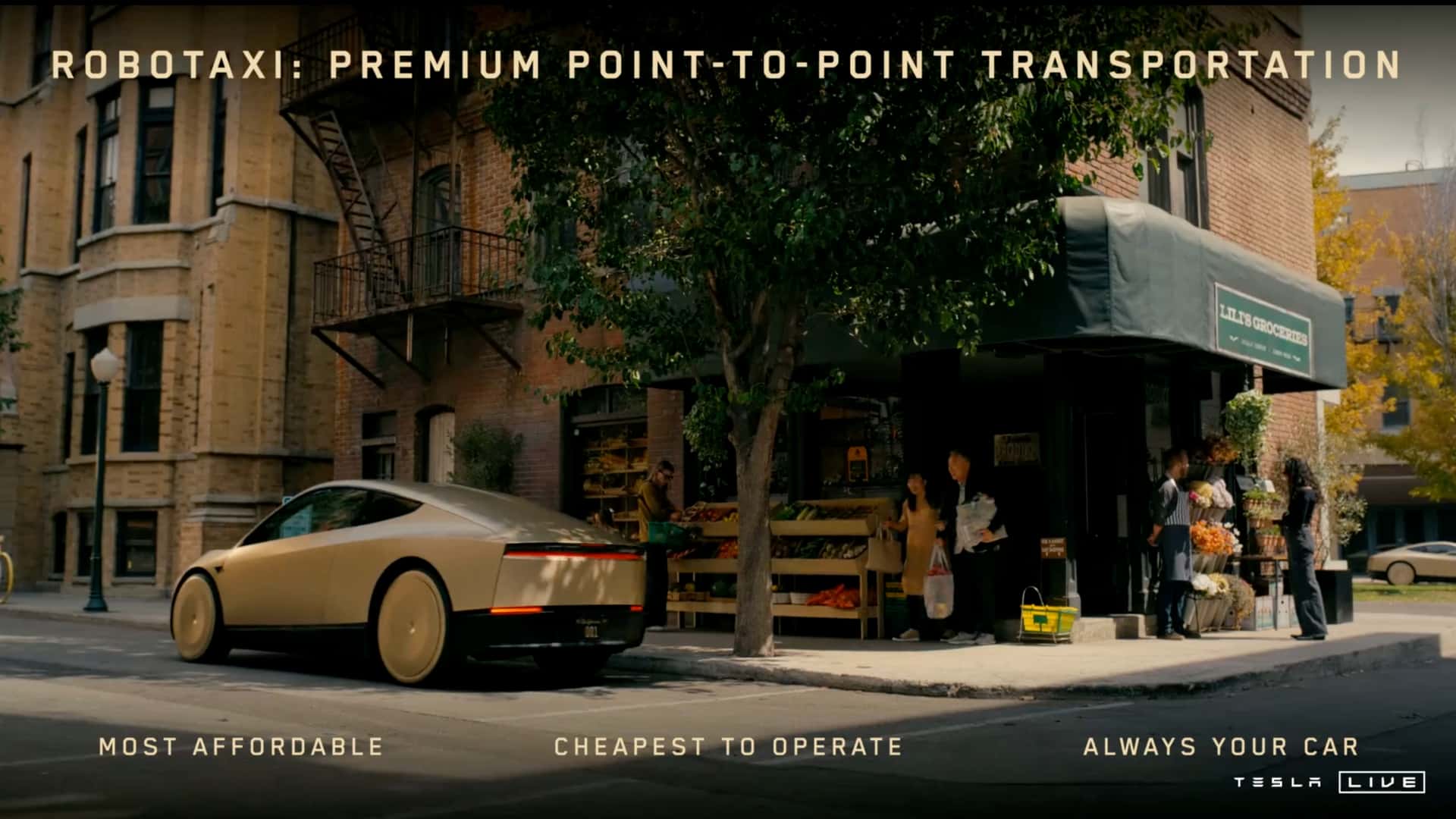- Tesla revealed its Cybercab self-driving taxi alongside a driverless Robovan.
- CEO Elon Musk was scant on details, but revealed the Cybercab doesn’t have a conventional charge port.
Well, it finally happened. Tesla revealed its much-anticipated Robotaxi, as well as a driverless Robovan during last night’s event at the Warner Bros. Discovery studio in Burbank, California.
It was the usual Elon Musk monologue with occasional random questions shouted from the audience–just like when that cool substitute teacher comes in and doesn’t really have all the details but is trying to make the best of it.
The whole reveal was devoid of technical details, so we don’t know what the battery size of the Cybercab is, how fast it charges, how fast it goes and whether it’s rear-wheel drive, front-wheel drive or all-wheel drive. Instead, Musk focused on the “optimistic” timeline where the driverless two-door would be on the road “by the end of 2027” and that it would cost under $30,000. Let’s not forget, however, that the second-generation Tesla Roadster was revealed in 2017 but is yet to become a series production model.
That said, he did give the audience one small piece of interesting information: the Tesla Cybercab will charge wirelessly through an inductive charger, and not by plugging in a cable into a charge port. In fact, it doesn’t even have a charge port, according to Musk, who very briefly touched on the subject during last night’s event
“Something we’re also doing is, and it’s really high time we did this, is inductive charging.,” he said. “So, The robotaxi has no plug. It just goes over the inductive charger and charges. So, yeah, that’s kind of how it should be. Thanks, guys. I love you, too.”
The quote was extracted from the live stream embedded below:
But that’s everything we know on the matter, and it’s not much. A lot of unanswered questions remain, like how much time it takes to recharge, how big is the inductive charger or how much it costs to buy the charger. These are all valid questions considering Tesla’s idea of the Cybercab is people will be able to buy one (or several) and operate a personal fleet of driverless cabs from the comfort of their homes. This essentially shifts the responsibility from the company to the individual and it also raises the costs associated with running such a fleet.
Musk mentioned that the Cybercab would be a great solution for people who are currently working for Uber and Lyft. In metropolitan areas, a lot of rideshare drivers already use electric vehicles, so they’re accustomed to charging an EV and taking care of it. But if they need to buy three inductive chargers for a small fleet of Cybercabs, the initial costs will likely be higher than expected.
Gallery: Tesla Cybercab








There’s also the issue of charging speeds. Current inductive charging solutions usually top out at around 20 kilowatts, which is significantly lower than the 250 kW maximum rate available at Tesla’s own Superchargers. Granted, there are wireless charging pad prototypes out there that reached 270 kW, but they’re still years away from becoming mainstream products.
So, how would this work, exactly? If it takes a whole night to recharge the Cybercab and then expect it to run all day doing trips, someone is going to have a bad time. Downtime is essential in the ride-hailing industry. Unless Tesla figures out a way to ship a wireless charging pad that’s affordable and capable of delivering enough juice to add significant range in a short amount of time, this isn’t going to work.
Tesla’s Robotaxi Won’t Have A Charge Port: It’s Wireless Charging Only
Tesla, the renowned electric vehicle manufacturer, has made waves in the automotive industry yet again with the announcement of its highly anticipated Robotaxi. However, one unique feature of this groundbreaking vehicle has caught the attention of many – it won’t have a traditional charge port. Instead, the Tesla Robotaxi will rely solely on wireless charging for its power needs.
This decision by Tesla to forego a charge port in favor of wireless charging represents a bold leap forward in the realm of electric vehicle technology. While traditional electric vehicles require drivers to manually plug in a charging cable to replenish their batteries, the Tesla Robotaxi will simply need to park over a designated wireless charging pad to begin charging.
This innovative approach to charging not only eliminates the need for drivers or passengers to physically plug in a charging cable, but it also offers a more seamless and convenient charging experience. With wireless charging, the Tesla Robotaxi can be automatically charged while parked in designated charging areas, ensuring that it is always ready to hit the road whenever needed.
Additionally, the absence of a charge port on the Tesla Robotaxi allows for a more streamlined and aerodynamic design. Without the need for a protruding charge port, the vehicle can achieve better aerodynamic efficiency, ultimately improving its overall performance and range.
While the concept of wireless charging is relatively new in the automotive industry, Tesla’s decision to incorporate this technology into the Robotaxi sets a new standard for electric vehicles. As the world shifts towards electric transportation, the demand for more efficient and convenient charging solutions will continue to grow. Tesla’s embrace of wireless charging with the Robotaxi marks a significant step towards meeting this demand.
Overall, Tesla’s decision to forgo a charge port in the Robotaxi in favor of wireless charging underscores the company’s commitment to innovation and pushing the boundaries of electric vehicle technology. As the automotive industry evolves, it is clear that Tesla will continue to lead the charge towards a future where electric vehicles are not only the norm, but also more convenient and efficient than ever before.

